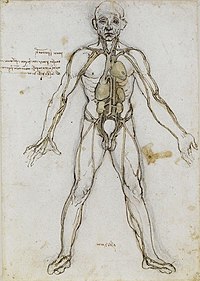List of bones of the human skeleton
 |
| Part of a series of lists about |
| Human anatomy |
|---|
The human skeleton of an adult usually consists of around 206 bones, depending on the counting of Sternum (which may alternatively be included as the manubrium, body of sternum, and the xiphoid process).[1] It is composed of 270 bones at the time of birth,[2] but later decreases to 206: 80 bones in the axial skeleton and 126 bones in the appendicular skeleton. 172 of 206 bones are part of a pair and the remaining 34 are unpaired.[3] Many small accessory bones, such as sesamoid bones, are not included in this. The precise count of bones can vary among individuals because of natural anatomical variations.
Introduction
[edit]As a person ages, some bones fuse, a process which typically lasts until sometime within the third decade of life. Therefore, the number of bones in an individual may be evaluated differently throughout a lifetime. In addition, the bones of the skull and face are counted as separate bones, despite being fused naturally. Some reliable sesamoid bones such as the pisiform are counted, while others, such as the hallux sesamoids, are not.
Individuals may have more or fewer bones than the average (even accounting for developmental stage) owing to anatomical variations. The most common variations include sutural (wormian) bones, which are located along the sutural lines on the back of the skull, and sesamoid bones which develop within some tendons, mainly in the hands and feet. Some individuals may also have additional (i.e., supernumerary) cervical ribs or lumbar vertebrae. Amputations or other injuries may result in the loss of bones. Complete bone fractures may split one bone into multiple pieces. Other genetic conditions may result in abnormally higher (e.g. polydactyly or conjoined twins) or lower (e.g. oligodactyly) counts of bones.
Bones
[edit]
The axial skeleton, comprising the spine, chest and head, contains 80 bones. The appendicular skeleton, comprising the arms and legs, including the shoulder and pelvic girdles, contains 126 bones, bringing the total for the entire skeleton to 206 bones. Infants are born with about 270 bones[4] with most of it being cartilage, but will later fuse together and decrease over time to 206 bones.
Head
[edit]
There are 23 bones in the skull. Including the bones of the middle ear and the hyoid bone, the head contains 29 bones.
- Cranial bones (8)
- Occipital bone
- Parietal bones (2)
- Frontal bone
- Temporal bones (2)
- Sphenoid bone (sometimes counted as facial)
- Ethmoid bone (sometimes counted as facial)
- Facial bones (15)
- Nasal bones (2)
- Maxilla (upper jaw) (2)
- Lacrimal bone (2)
- Zygomatic bone (cheek bones) (2)
- Palatine bone (2)
- Inferior nasal concha (2)
- Vomer (1)
- Hyoid bone (1)
- Mandible (1)
- Middle ears (6 bones in total, 3 on each side)
Chest (thorax)
[edit]There are 25 bones in the chest. The chest contains cartilage for the lungs to fill with air.
- Sternum (1 or 3 bones. It is counted as 1 in this article.)
- Ribs (24, in 12 pairs)
- Cervical ribs are extra ribs that occur in some people.
Spine (vertebral column)
[edit]A fully grown adult features 26 bones in the spine, whereas a child can have 33.
- Cervical vertebrae (7 bones)
- Thoracic vertebrae (12 bones)
- Lumbar vertebrae (5 bones)
- Sacrum (5 bones at birth, fused into one after adolescence)
- Coccyx (set of 4 bones at birth)
Pelvis
[edit]The pelvis consists of two parts: anterior and posterior. Note that the posterior bones comprise the lower parts of the spine, where they are primarily counted to.
- Anterior bone (hip bone or pelvic girdle) (1)
- Posterior bones (pelvic spine)
Upper limb (arm and forearm) and hand
[edit]There are a total of 64 bones in the arms, 32 in each arm
- Upper arm bones (6 bones in total; 3 on each side)
- Humerus (2)
- Pectoral girdle (shoulder)
- Lower arm bones (4 bones in total, 2 on each side) left bone
- Hand (54 bones in total; 27 in each hand)
- Carpals
- Scaphoid bone (2)
- Lunate bone (2)
- Triquetral bone (2)
- Pisiform bone (2)
- Trapezium (2)
- Trapezoid bone (2)
- Capitate bone (2)
- Hamate bone (2)
- Metacarpals (10 bones in total; 5 on each side)
- Phalanges of the hand (28 bones in total, 14 on each hand)
- Proximal phalanges (10 bones in total; 5 on each side)
- Intermediate phalanges (8 bones in total; 4 on each side)
- Distal phalanges (10 bones in total; 5 on each side)
- Carpals
Lower limb (thigh and leg) and foot
[edit]There are a total of 8 bones in the legs and 52 in the feet.
- Femur (2)
- Patella or kneecap (2)
- Tibia (2)
- Fibula (2)
- Foot (52 bones in total, 26 per foot)
- Tarsus
- Calcaneus or heel bone (2)
- Talus (2)
- Navicular bone (2)
- Medial cuneiform bone (2)
- Intermediate cuneiform bone (2)
- Lateral cuneiform bone (2)
- Cuboid bone (2)
- Metatarsals (10)
- Phalanges of the foot (28 bones in total, 14 per foot)
- Proximal phalanges (10)
- Intermediate phalanges (8)
- Distal phalanges (10)
- Tarsus
See also
[edit]- Human body
- Blood vessel
- Circulatory system
- Outline of human anatomy
- List of nerves of the human body
- List of glands of the human body
- List of skeletal muscles of the human body
References
[edit]- ^ Human Body (206). Rensselaer Polytechnic Institute
- ^ Mammal anatomy : an illustrated guide. New York: Marshall Cavendish. 2010. p. 129. ISBN 9780761478829.
- ^ Beck, Kevin. "How Many Bones Are in a Body?". Sciencing. Retrieved 21 August 2023.
- ^ Mammal anatomy : an illustrated guide. New York: Marshall Cavendish. 2010. p. 129. ISBN 9780761478829.
